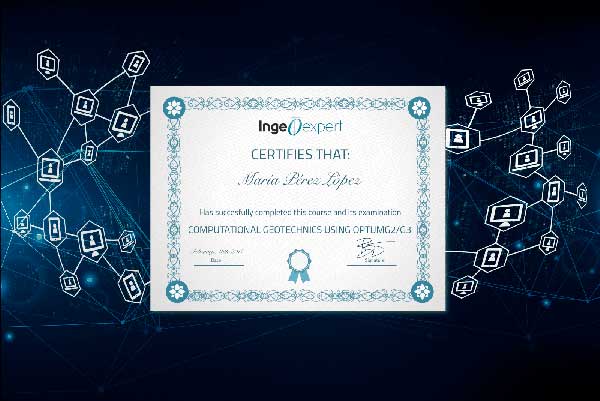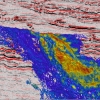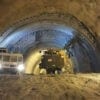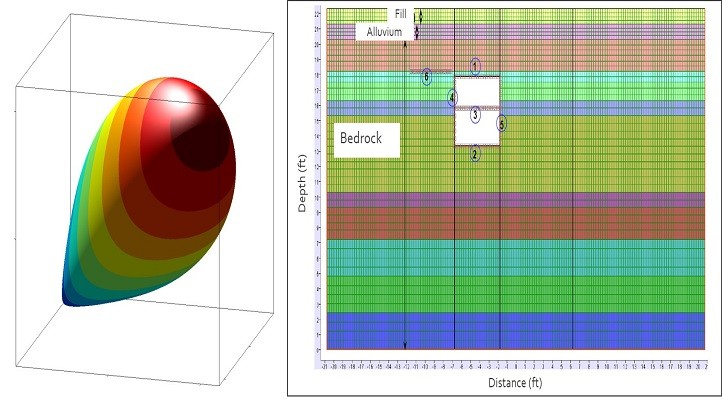Constitutive Models in Geotechnical Engineering Applications
50 hours / 6 weeks |
|
Online course |
|
Dates: to be determined |
Introduction
Modelling of soil behavior in geotechnical problems have been generally solved by the principles of linear elasticity (Hooke’s Law) or perfect plasticity (Coulomb’s Law) due to the simplicity of its applications. In addition to the soil behavior, its condition of failure has been widely represented by the Mohr-Coulomb model or elastic-plastic theory. However, is well know the soil does not behave as linear elastic or perfectly plastic during the entire load range and its behavior is more complex and subject to diverse conditions.
A large variety of constitutive models have been proposed by diverse researches during the recent decades to describe the behavior of soils. All these models present advantages and limitations that also largely depending on its applications. No model can completely describe the real soil behavior under all conditions. In addition, the complexity of the soil model is proportional to the number of parameters required to use it. For geotechnical engineering applications soil data is usually limited to results obtained from basic field and laboratory tests and there is often limited data that can be used for the selection. However, the practice is leading to the use of the more sophisticated methods and geotechnical engineers should be prepared to properly select soil models and engineering parameters to be used in combination with the use of available software for geotechnical applications.
This course will introduce you to methods commonly used in the geotechnical engineering practice for modeling soil behavior and provide you with the key concepts to select material parameters and properly apply principles of numerical modeling methods (e.g., finite element method, finite differences method).
Objectives
By the end of the course you will be able to:
- Understand principles and applications of methods available for modelling soil behavior
- Recognize advantages and limitations of the different constitutive models
- Understand how to select appropriate model parameters from available field and laboratory data
- Understand how to apply a constitutive model using numerical methods (Finite Element Method, Finite Differences Method) available for engineering computer software (e.g., Plaxis, FLAC) to analyze a variety of geotechnical problems
Limited places.
Module 1 – Introduction
-
- Geotechnical Engineering Modelling
- Characteristics of Soil Behavior
- Stress Paths
- Pore-Pressure Changes
Module 2 – Elastic, Plastic, Elastic-Plastic Models
-
- Definitions
- Elastic Models
- Perfectly-Plastic Models
- Yield Surface
- Mohr-Coulomb
- Extended Mohr-Coulomb
Module 3 –Other Advanced Models
-
- Cam-Clay
- Hardening Models
- Hypoplastic Models
Module 4 – Numerical Methods in Soil Modelling – Finite Element Method (FEM)
-
- Introduction to FEM
- Available Constitutive Models in Plaxis
- Practice Case
Module 5 – Numerical Methods in Soil Modelling – Finite Difference Method (FDM)
-
- Introduction to FDM
- Available Constitutive Models in FLAC
- Practice Case
Module 6 – Models for Dynamic Loading / Earthquake-Induced Deformations
Diana Reyes
Dr. Diana Reyes is a Senior Engineer at Group Delta Consultants in Southern California, US. Dr. Reyes is a graduate holds a PhD and MSc’s degrees in Civil (Geotechnical and Earthquake) Engineering from Los Andes University in Bogota, Colombia, with a PhD research scholar in Washington State University in the United States.
Dr. Reyes has fourteen years of diversified professional experience in geotechnical and earthquake engineering. Her experience covers aspects of the consulting engineering and the research in geotechnical earthquake engineering, specializing in probabilistic seismic hazard analysis, site response, and constitutive modeling of geomaterials. Dr. Reyes has experience in geotechnical engineering analysis, foundation design, seismic hazard evaluations, site response analysis, ground motion design, liquefaction potential evaluation, and non-linear soil-structure interaction. Projects Dr. Reyes has worked include nuclear power plants, oil and gas pipelines, offshore platforms, marine ports and harbors, levees, large transportation infrastructure, hospitals, and schools within United States and Internationally (Latin America, Middle East, Africa, southeast Asia, and eastern Europe).
Within this virtual platform, students are in continuous contact with professor in a tailored way, solving questions together, and widening knowledge and acquiring new skills. Students can also interact with other students and professors through webinars and forums.
Plenty of content can be found in the Campus: eLearning material, videos, technical articles, manuals, complementary documentation, real examples and exercises.
Prerequisites
The students are supposed to have knowledge of Soil Mechanics
This Course is Designed For
- Practice civil engineers involved in the analysis and design of geotechnical problems, who are interesting in learning and applying diverse advanced models to represent soil behavior, and
- Civil engineers engaged with computer software that would like to advance on the use of numerical methods in solving geotechnical problems through advanced constitutive models
As evidence of knowledge gained throughout the course, a certificate will be issued from the Virtual platform. This certificate is based on the modern technology Blockchain, which increases security, prevents fraud, builds trust and ensures you’re ready for the future.
The content presented in this course will provide the student with the key basis and knowledge of available models used to represent the soil behavior in geotechnical problems. The ability of understand diverse soil models, being able to select soil parameters, and successfully apply them in conjunction with a numerical method to resolve a complex geotechnical problem, will add value to the student skills and put him/her in a higher-end engineering level compared to the competition.
Introduction
Modelling of soil behavior in geotechnical problems have been generally solved by the principles of linear elasticity (Hooke’s Law) or perfect plasticity (Coulomb’s Law) due to the simplicity of its applications. In addition to the soil behavior, its condition of failure has been widely represented by the Mohr-Coulomb model or elastic-plastic theory. However, is well know the soil does not behave as linear elastic or perfectly plastic during the entire load range and its behavior is more complex and subject to diverse conditions.
A large variety of constitutive models have been proposed by diverse researches during the recent decades to describe the behavior of soils. All these models present advantages and limitations that also largely depending on its applications. No model can completely describe the real soil behavior under all conditions. In addition, the complexity of the soil model is proportional to the number of parameters required to use it. For geotechnical engineering applications soil data is usually limited to results obtained from basic field and laboratory tests and there is often limited data that can be used for the selection. However, the practice is leading to the use of the more sophisticated methods and geotechnical engineers should be prepared to properly select soil models and engineering parameters to be used in combination with the use of available software for geotechnical applications.
This course will introduce you to methods commonly used in the geotechnical engineering practice for modeling soil behavior and provide you with the key concepts to select material parameters and properly apply principles of numerical modeling methods (e.g., finite element method, finite differences method).
Objectives
By the end of the course you will be able to:
- Understand principles and applications of methods available for modelling soil behavior
- Recognize advantages and limitations of the different constitutive models
- Understand how to select appropriate model parameters from available field and laboratory data
- Understand how to apply a constitutive model using numerical methods (Finite Element Method, Finite Differences Method) available for engineering computer software (e.g., Plaxis, FLAC) to analyze a variety of geotechnical problems
Limited places.
Module 1 – Introduction
-
- Geotechnical Engineering Modelling
- Characteristics of Soil Behavior
- Stress Paths
- Pore-Pressure Changes
Module 2 – Elastic, Plastic, Elastic-Plastic Models
-
- Definitions
- Elastic Models
- Perfectly-Plastic Models
- Yield Surface
- Mohr-Coulomb
- Extended Mohr-Coulomb
Module 3 –Other Advanced Models
-
- Cam-Clay
- Hardening Models
- Hypoplastic Models
Module 4 – Numerical Methods in Soil Modelling – Finite Element Method (FEM)
-
- Introduction to FEM
- Available Constitutive Models in Plaxis
- Practice Case
Module 5 – Numerical Methods in Soil Modelling – Finite Difference Method (FDM)
-
- Introduction to FDM
- Available Constitutive Models in FLAC
- Practice Case
Module 6 – Models for Dynamic Loading / Earthquake-Induced Deformations
Diana Reyes
Dr. Diana Reyes is a Senior Engineer at Group Delta Consultants in Southern California, US. Dr. Reyes is a graduate holds a PhD and MSc’s degrees in Civil (Geotechnical and Earthquake) Engineering from Los Andes University in Bogota, Colombia, with a PhD research scholar in Washington State University in the United States.
Dr. Reyes has fourteen years of diversified professional experience in geotechnical and earthquake engineering. Her experience covers aspects of the consulting engineering and the research in geotechnical earthquake engineering, specializing in probabilistic seismic hazard analysis, site response, and constitutive modeling of geomaterials. Dr. Reyes has experience in geotechnical engineering analysis, foundation design, seismic hazard evaluations, site response analysis, ground motion design, liquefaction potential evaluation, and non-linear soil-structure interaction. Projects Dr. Reyes has worked include nuclear power plants, oil and gas pipelines, offshore platforms, marine ports and harbors, levees, large transportation infrastructure, hospitals, and schools within United States and Internationally (Latin America, Middle East, Africa, southeast Asia, and eastern Europe).
Within this virtual platform, students are in continuous contact with professor in a tailored way, solving questions together, and widening knowledge and acquiring new skills. Students can also interact with other students and professors through webinars and forums.
Plenty of content can be found in the Campus: eLearning material, videos, technical articles, manuals, complementary documentation, real examples and exercises.
Prerequisites
The students are supposed to have knowledge of Soil Mechanics
This Course is Designed For
- Practice civil engineers involved in the analysis and design of geotechnical problems, who are interesting in learning and applying diverse advanced models to represent soil behavior, and
- Civil engineers engaged with computer software that would like to advance on the use of numerical methods in solving geotechnical problems through advanced constitutive models
As evidence of knowledge gained throughout the course, a certificate will be issued from the Virtual platform. This certificate is based on the modern technology Blockchain, which increases security, prevents fraud, builds trust and ensures you’re ready for the future.
The content presented in this course will provide the student with the key basis and knowledge of available models used to represent the soil behavior in geotechnical problems. The ability of understand diverse soil models, being able to select soil parameters, and successfully apply them in conjunction with a numerical method to resolve a complex geotechnical problem, will add value to the student skills and put him/her in a higher-end engineering level compared to the competition.
More info
Finish this course and get a certificate based on Blockchain
Constitutive Models in Geotechnical Engineering Applications

Blockchain technology makes the certificate incorruptible, enabling companies to verifiy its autenticity.





Reviews
There are no reviews yet.